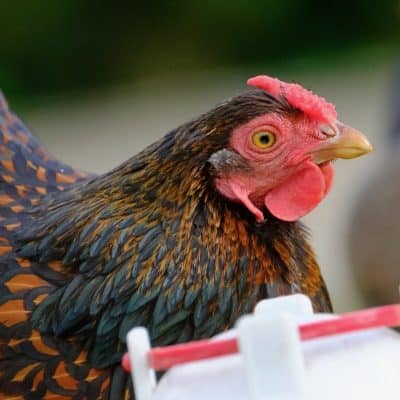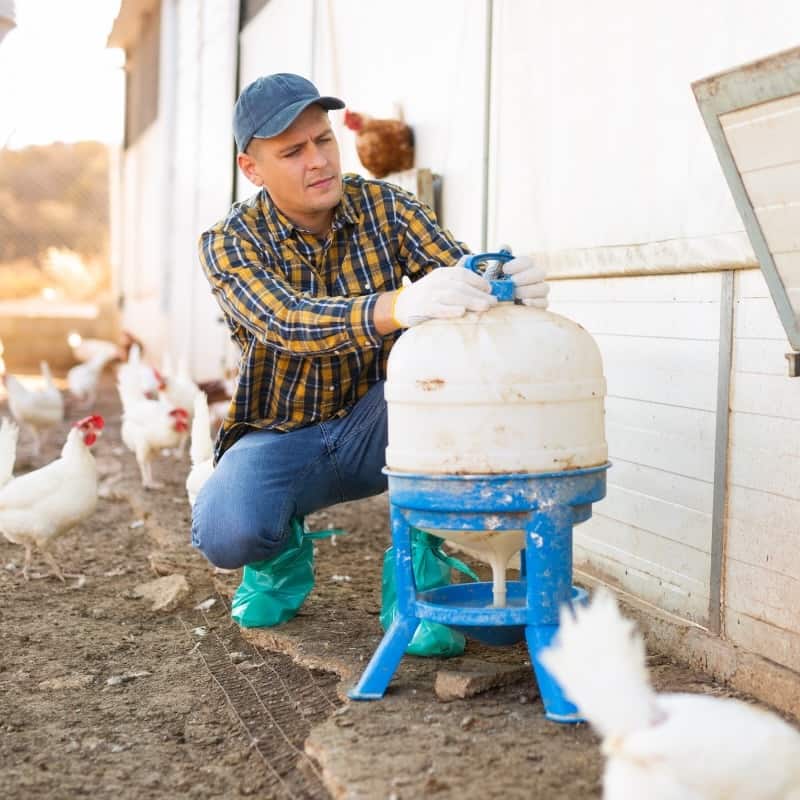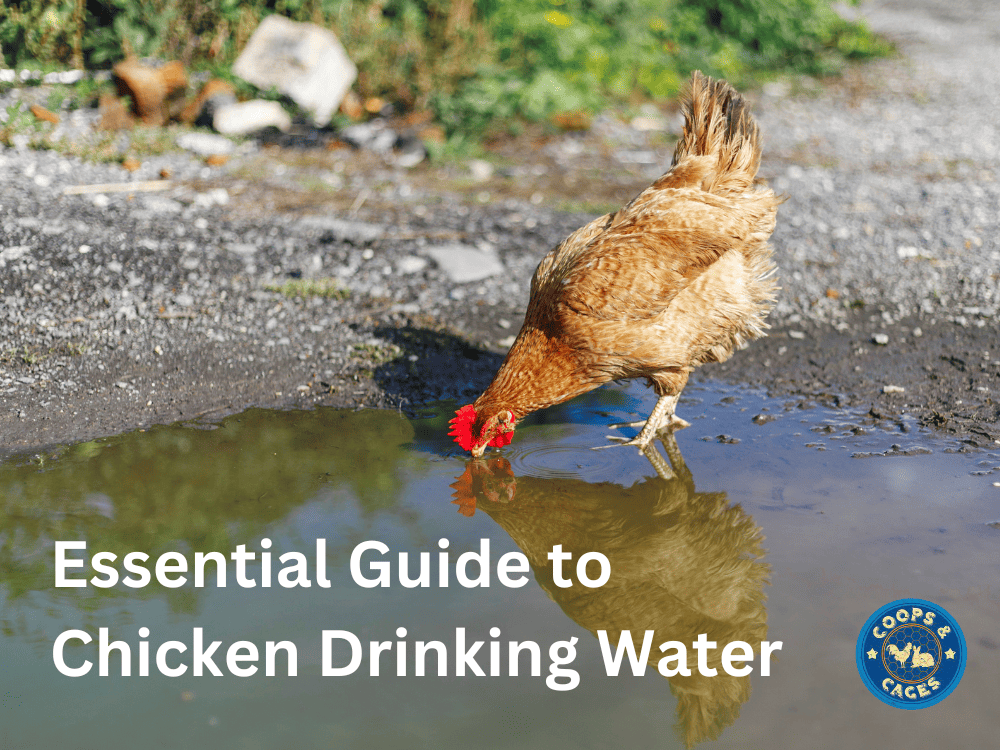Discover the secrets to keeping your feathered companions happy and healthy in our comprehensive guide to chicken drinking water.
From understanding their unique hydration needs to debunking common myths and practical tips on maintaining clean water containers, this blog covers it all. Join us on a cluck-worthy journey as we explore the importance of clean water, various types of chicken waterers, and how to spot signs of dehydration.
Coops and Cages is here to empower chicken owners with the knowledge needed for optimal care. Let’s dive into the world of chicken drinking water and ensure your chooks stay refreshed and thriving!
Understanding Chicken Hydration Needs
Hydration is essential to raise happy, healthy chooks.
How Much Water Do Chickens Need?
Offer chickens constant access to clean fresh water. The average chicken drinks about 500ml of water per day. But this can increase based on age, diet, climate, and egg production. A simple way to gauge if your chickens are getting enough water is by observing them closely.
Healthy chickens will be active and alert with bright eyes. If you notice any changes in behaviour or physical appearance like lethargy or dull-looking feathers, it might mean they’re not drinking enough. Make sure there’s always plenty of clean water available in their coop.
Importance of Clean Drinking Water
Dirty drinking containers can harbour harmful bacteria which could make your birds sick. It’s essential that we keep our flock’s hydration pristine so they remain healthy.
Types of Chicken Waterers
You will need to place chicken drinkers close to the poultry house. For large flocks, its a good idea to have multiple drinkers. When choosing which type of drinker, consider budget and the size of your flock. Common options include:
Open Water Containers
Open troughs work well for small flocks as they are easy to refill. However, they do require regular cleaning to keep the water water free from contaminated droppings.
Bell-Shaped Drinkers
Bell drinkers have a moat around the base where your flock are able to access water. This stops the chickens from being able to jump into their water and make a mess. Bell drinkers can be hung from the roof to stop chickens knocking them over.
Nipple Drinkers
Nipple drinkers use gravity-fed nipples which release drops of water when pecked by hens ensuring no wastage or messiness associated with other methods. This innovative solution reduces contamination risk because birds aren’t dipping their heads into open containers where dust and debris could fall in.

Maintaining Clean Drinking Water for Chickens
Chickens, just like us humans, need clean water to stay healthy. But keeping their water clean can be a bit tricky due to their curious nature and tendency to scratch around.
The first step in water management is choosing water containers that prevent chickens from standing or pooping in them. A hanging or elevated drinker could work well for this purpose.
Cleaning Routine
To keep the chicken’s water spotless, you’ll need a regular cleaning routine. Rinse out the drinkers’ water content daily before refilling them with fresh water.
This prevents green algae build-up and bacteria growth that might make your chooks sick. A deeper clean once every week using apple cider vinegar will also help maintain cleanliness. Remember to rinse thoroughly afterwards.
Drinking Water Quality Check
Tap water is generally safe if it’s good enough for human consumption; however if you’re using rainwater or natural sources, consider testing its safety regularly because contaminants can sometimes sneak in unnoticed.
You might find an off-the-shelf water test kit handy for this job – they’re easy-to-use and give instant results about various aspects such as pH level and presence of non-organic matter.
Avoid Stagnant Water
Stagnant water can attract mosquitoes and other insects. To avoid this, chicken keepers should try not to overfill the drinkers – give just enough water supply for each day.
Signs of Dehydration in Chickens
An important part of chicken keeping is recognising the signs of dehydration and increase water if needed. Chicken health is your responsibility!
Droopy Appearance
A dehydrated chicken’s body may appear lethargic or droopy with ruffled feathers. Sick chickens tend not to interact much with their flock mates and prefer staying isolated.
Panting and High Body Temperature
In an attempt to cool down and compensate for lack of water intake, your chooks might start panting excessively while also having high body temperature.
This behaviour is more common during hot weather but if it continues despite providing ample clean water then immediate action should be taken.
Lack of Appetite
Dehydrated chickens often show reduced appetite or complete refusal to eat. They might also exhibit weight loss over time due to their decreased feed consumption.
Sunken Eyes & Dry Comb/Wattles
Sunken eyes are a classic sign that your feathered friends aren’t getting enough fluids whereas dry combs/wattles indicate severe dehydration which needs immediate attention (PoultryDVM).
The sooner you identify these symptoms; the sooner you can take action to help your chickens.
Jordan’s Tip:
Go beyond the water dish – ensure your chooks stay refreshed by introducing moisture-rich treats like watermelon, cucumbers, and berries into their diet.
3 Myths about Chicken Hydration
Chickens, like all living creatures, need water to survive. But there are a few myths floating around that can confuse any chook owner. Let’s put to bed some of those misconceptions.
1. Chickens Don’t Need Much Water in Winter
While its true that chickens drink extra in warmer weather, they still need plenty of drinking water in winter too. This is because they expend energy to keep warm, leading to increased water intake.
2. Any Water Source Will Do
A misconception we often hear at Coops and Cages is that free ranging chickens can drink from any source – puddles included. The truth? They need clean drinking water just as much as you do. Dirty or stagnant water could cause diseases.
3. Larger Breeds Need More Water Than Smaller Ones
You might think larger chicken breeds would gulp down more H20 than their smaller counterparts but it’s not always the case. Factors such as diet, age and temperature have a greater influence on how much your chook drinks.

FAQs in Relation to Chicken Drinking Water
How Do Chickens Drink Water?
Chickens scoop up water using their beaks, tilt their heads back, and let the water trickle down.
How Much Water Does A Chicken Drink In 24 Hours?
A mature chicken generally guzzles about half a litre of water daily, but this varies depending on factors like age, diet and weather.
Why Aren’t My Chickens Drinking Water?
If your chooks aren’t drinking, they could be sick or stressed. Also, check if the watering system is working properly and the water’s clean.
Jordan’s Wrap
Here at Coops and Cages, we’re dedicated to assisting chicken keepers in providing optimal care. Understanding the importance of chicken drinking water is crucial for healthy, happy chooks.
Owners must select the appropriate waterers, learn to recognise signs of dehydration, and regularly clean water containers.
Remember this: proper hydration isn’t just important – it’s essential. So keep an eye on your chooks’ water intake and make sure they’re always hydrated well.



